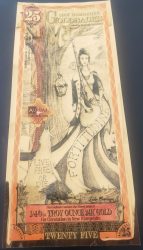
By Ben DeJong
In the realm of monetary innovation, the Goldback stands out as a unique form of interchangeable and physical gold money. Unlike traditional gold products, Goldbacks are designed to function as a currency with interchangeable denominations, making them a versatile and practical means of exchange. This article explores the distinctive features, applications, and considerations surrounding Goldbacks, emphasizing its role as both a gold product and a potential currency within some states.
The Goldback’s uniqueness lies in its interchangeable denominations, offering a practical solution for small transactions. A series of Goldbacks have been minted to circulate within the legal frameworks of Utah, Nevada, Wyoming, and New Hampshire. The ability to trade higher denominations for multiples of lower denominations, such as converting a fifty denomination (1/20th of an oz) for fifty-one denominations (1/1,000th of an oz), adds to its functionality.
Goldbacks carry intrinsic value and can be bartered globally. Their ease of use in small transactions and absence of varying premiums set them apart from other gold products, making them a convenient choice for everyday transactions.
The Goldback merges the concept of local currencies and gold products, offering a unique marriage of the two. Functioning as both a gold product and a potential currency in jurisdictions where authorized by law, the Goldback represents a novel approach to combining the value of gold with the practicality of circulating currency.
Goldbacks are priced at the current average rate, ensuring that their value remains consistent with market conditions. While Goldback Inc. cannot control retail prices set by independent sellers, consumers are advised to research and avoid paying more than the average exchange rate. Despite being a gold-backed currency, Goldbacks are priced approximately 25% cheaper than other gold products with the same weight, providing consumers with a cost-effective option.
The technology behind the Goldback includes robust anti-counterfeiting features, such as visible and tangible negative images, glistening gold properties, and government-level security features on the front. Developed over two decades, the technology is protected by trade secrets and patents, making counterfeiting a formidable challenge.
*Article was featured in the December 2023 Michigan Libertarian newsletter.

